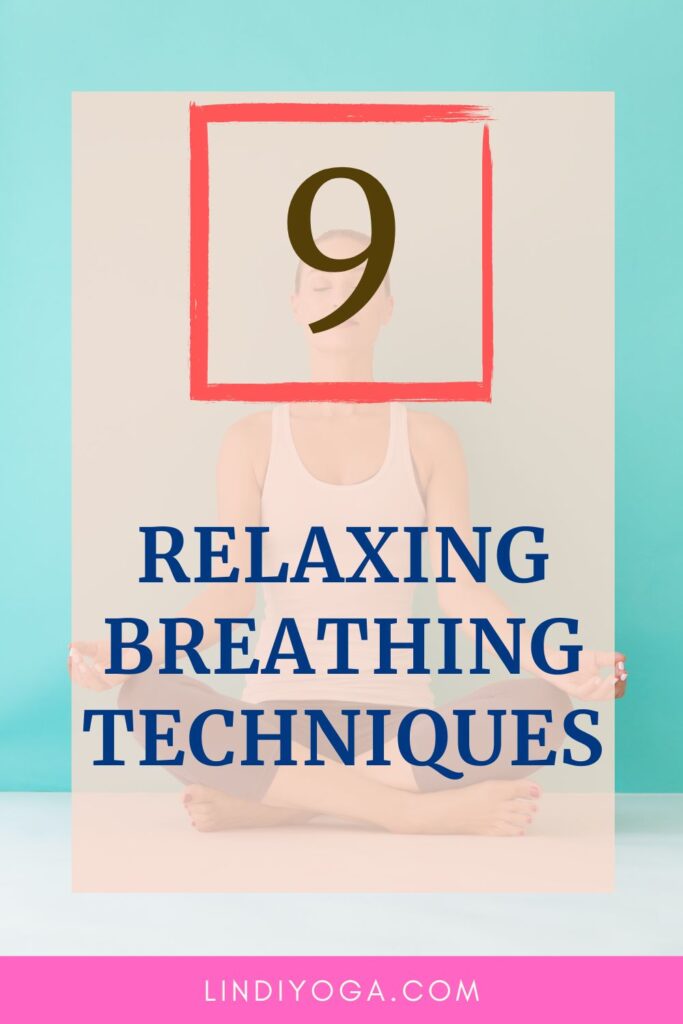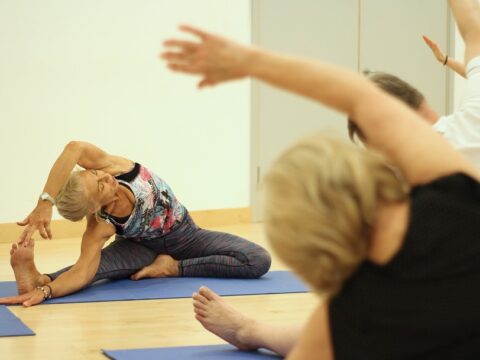Breathing is so important. When inhaling, blood cells take in oxygen. They release carbon dioxide. Carbon dioxide is a waste product recycled and exhaled by your body.
Breathing wrong can mess up the oxygen and carbon dioxide exchange. This can make you prone to anxiety, panic attacks, fatigue, and other issues. Physical and emotional problems may occur. Next anxious time, try breathing exercises for anxiety.
Anxious from shallow breathing?
Next anxious time, it may be shallow breathing. Many doing yoga have anxiety. They don’t know the cause. Seems backwards to breathe shallowly when anxious. But it creates more stress.
Deep breathing calms you. Good when stressed. Here’s why shallow breathing causes anxiety and proper breathing.
Deep breathing calms
Deep breathing fills you with oxygen. Releases tension throughout. In yoga videos, teachers exhale during moves. Deep breathing relaxes muscles best. Also very effective for sleep.
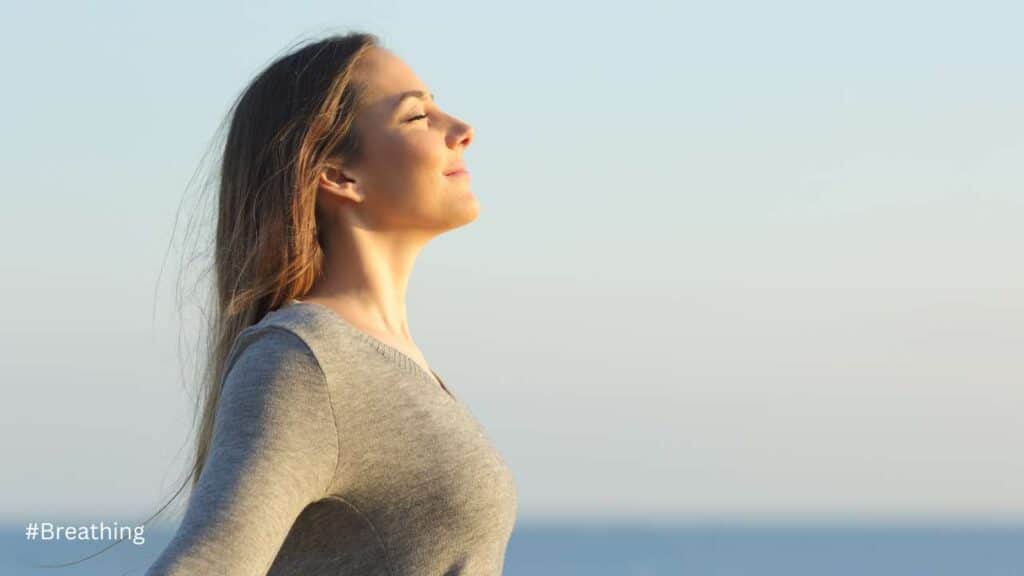
Chest breathing vs. belly breathing
What’s the difference between chest and belly breathing?
The chest has the lungs, diaphragm, heart, and ribs. The lungs take in oxygen and expel carbon dioxide.
The diaphragm is the muscle moving your lungs up and down. It’s under the ribs and heart.
The heart pumps blood.
The ribs protect organs and provide body structure.
Chest breathing feels like:
Chest and upper back muscles are used. You breathe in and out with your chest.
Belly breathing feels like:
Abdomen and lower back muscles are used. You breathe with your belly in and out.
How to add breathing exercises to your day:
You can do them anywhere without equipment. Many types suit different needs.
You don’t need much time. Start with 5 minutes daily, adding time as it gets easier and enjoyable.
If 5 is too long, start with 2 minutes.
Practice several times daily. Schedule times or do conscious breathing when needed.
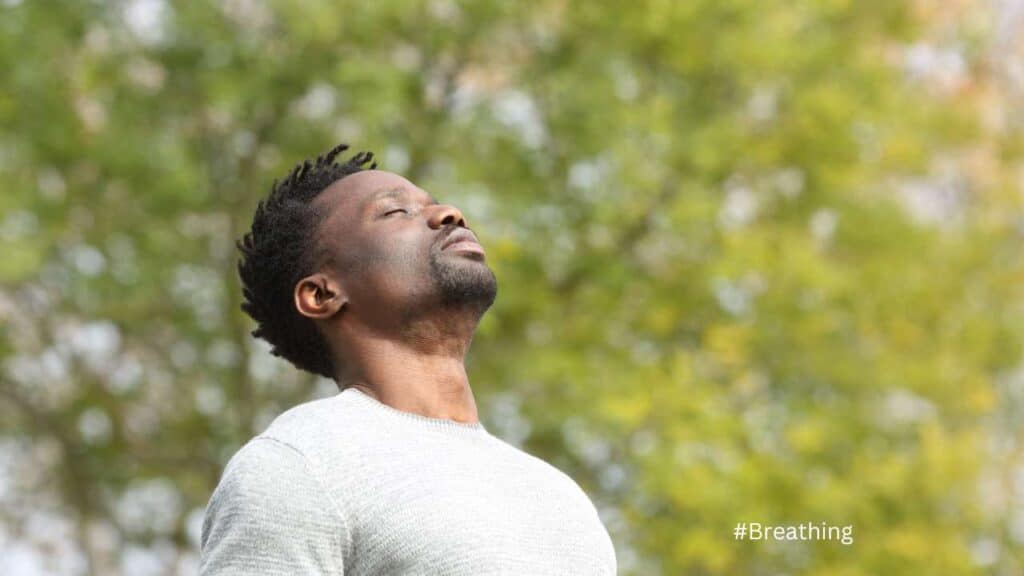
10 Breathing techniques to reduce stress
Before you start breathing exercises, talk to your doctor or a breath exercises professinal.
The Lion’s Breath
The Lion’s Breath can help you relax and feel calmer. If you haven’t heard of it, it’s very similar to the cobra posture you may know.
It is very easy to learn. Here are some good tips to help you practice this technique.
- Lie on your back.
- Breathe in slowly and deeply through your nose.
- Hold the breath for two seconds and slowly release the exhalation.
- Repeat this cycle three times.
- When you have finished, roll onto your left side.
- Inhale slowly and deeply through your nose.
- Hold the breath for five seconds and slowly exhale again.
- Repeat this cycle three times.
- When you have finished, roll onto your right side.
- Inhale slowly and deeply through your nose.
- Hold the breath for five seconds and exhale slowly.
- Repeat this cycle three times.
Pursed lip breathing
Pursed lip breathing is an important part of yoga practice, but most people don’t know how to do it.
How to perform the breathing exercise with lips pressed together
- You should sit upright with your spine straight. You can sit on a couch or chair for this, or even stand.
- When you begin to breathe, you should feel your chest expand. This is normal. You may also feel your stomach rise. This is natural, but you do not want to lift your chest and stomach with your breathing.
- Now that you have your body in position, focus on your lips. You will notice that they are already pursed a little naturally.
- Do not close your mouth completely. Close your mouth so far that you feel a resistance to the air, especially when you exhale.
- Hold this position for several breaths and slowly return to your normal breathing after a few breaths.
When you have finished this exercise, you should feel relaxed and ready for whatever the rest of the day has in store for you.
Breath focus technique
Many people say that diaphragmatic breathing is the most effective way to relax your body and mind, and it’s certainly a great way to calm down when you’re stressed. But there are alternatives too.
Here’s a simple breathing technique you can use any time you need to calm down.
Breathe in through your nose and out through your mouth.
While doing this, keep your belly relaxed and imagine the air coming in through the top of your head and out through your feet.
The more you practice this, the more you will learn how to use your breath to relax your body and mind.
Alternate nostril breathing
We each have two nostrils, and each nostril has its own muscles. One nostril smells, the other inhales. Then they switch roles. Knowing when and how you breathe is vital for optimal health. Roughly 90% of the air going to your lungs enters through one nostril.
So it’s important to learn alternate breathing. It’s considered the simplest, safest breathing exercise.
That’s why its benefits are widely known. Breathing through one nostril inhales negative ions, which help heal the body.
Exhaling through that nostril releases negative ions and stress. Thus this exercise relieves stress.
Breathing through the other nostril inhales positive ions, which calm the mind.
Conversely, exhaling through that nostril releases positive ions, relieving depression.
Inhaling and exhaling through one nostril takes in positive and negative ions. We also feel nature’s calming effect.
To practice alternate nostril breathing
- Sit comfortably and close your eyes.
- Breathe in slowly three times.
- Concentrate on the left nostril with each breath.
- Let the air out of the left nostril and then concentrate on the right nostril.
- Inhale through the right nostril and exhale through the left nostril.
- Repeat steps four and five until you feel relaxed.
- To finish the exercise, focus on the left nostril again.
- Let the air out of the left nostril and then concentrate on the right nostril.
- Inhale through the right nostril and exhale through the left nostril.
- Repeat steps eight and nine until you feel relaxed.
- To finish the exercise, concentrate on the right nostril again.
- Let the air out of the right nostril and then concentrate on the left nostril.
- Inhale through the left nostril and exhale through the right nostril.
- Repeat steps twelve and thirteen until you feel relaxed.
- To finish the exercise, concentrate on the right nostril again.
Belly Breathing
Belly breathing helps you stay calm, relaxed, and stress-free. It’s a simple yet deep natural breath. But it takes practice to master.
Belly breathing is used in meditation or guided imagery. It relaxes the body and mind. Do it anytime, anywhere. No need to wait for meditation.
No equipment is required. Just use your breath.
If you want a quick, easy stress relief and relaxer, try belly breathing. It’s one of the best daily tools I know.
Benefits of belly breathing
This breathing is simple yet profoundly affects health and wellbeing. It reduces anxiety, depression, stress. It improves mood.
It also aids focus, concentration, memory. Done right, you’ll feel calmer in any situation.
How to do belly breathing
Belly breathing is breathing air into your lungs so your belly moves in and out. Breathe in through your nose. Breathe out through your mouth. This fills your lungs with air. Your belly expands as you inhale. Your belly contracts as you exhale.
Belly breathing is easy to learn. There are two main methods – the rolling method and the stretching method.
For the rolling method, put your hands on your belly. Keep your palms facing in. As you inhale, roll your hands up your belly. This helps the air flow into your lungs. When you exhale, you should feel your belly expand and contract.
For the stretching method, put your hands on your abdomen. Keep your palms facing you. As you inhale, gently stretch your arms forward. This ensures the air enters your lungs, not your throat. You should feel your belly move in and out.
Here are some belly breathing tips:
You don’t need a deep breath. Just breathe enough to fill your lungs. Breathe in through your nose. Breathe out through your mouth. Make sure your belly moves in and out with each breath.
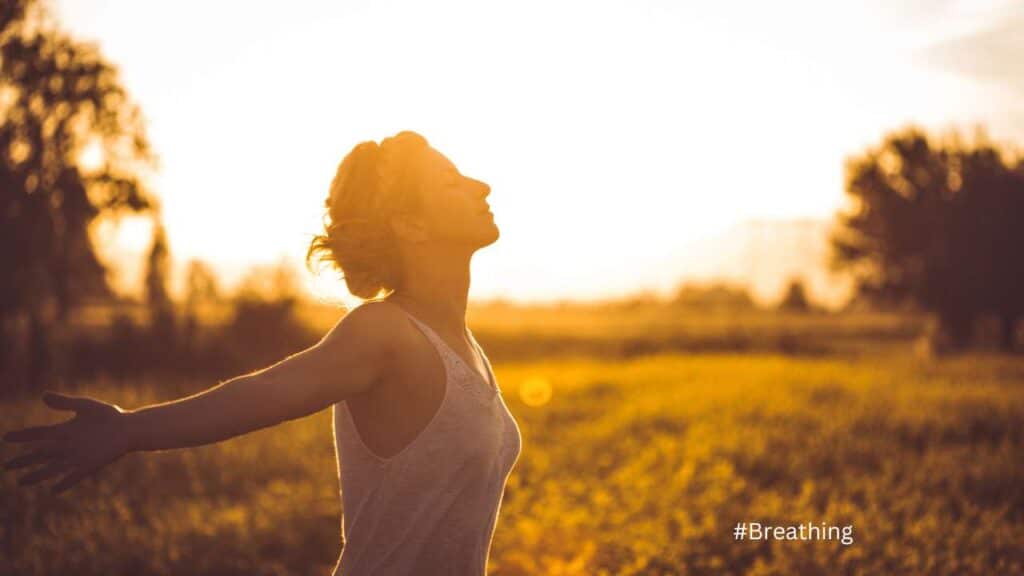
Box breathing
Get ready to learn box breathing. I will explain it step-by-step. Box breathing relaxes your mind and body. You can do it anywhere. But pick the right place.
Choose somewhere quiet and free of distraction. Avoid noisy, busy areas. Find a peaceful spot to focus.
Use a chair with enough room to lay back. Don’t lean too far in any direction. Stay comfortable.
Lie on a soft cushion. It should support your head and neck. But allow easy breathing.
The key is being comfortable and focused. Then you can fully relax with box breathing. Follow the steps closely for best results. This technique will calm your mind and body.
How Does Box Breathing Work?
- Once you are ready to practice box breathing, lie on the floor or your chair.
- Place your right hand behind your head, and the left hand on top of your chest.
- Now, inhale slowly through your nose, and hold the air inside your lungs for a few seconds.
- After you exhale, release the air through your mouth, but don’t let go of your breath.
- After you have finished this, inhale again slowly through your nose, and hold the air inside your lungs for a few seconds.
- After you exhale, release the air through your mouth, and repeat this process for 10 times.
- The last step is to inhale and exhale normally for a few seconds, and then slowly exhale and rest for a few seconds.
Repeat this exercise 3 times, and you will be done.
Box breathing is an exercise that is used to increase your awareness of your body. It is often done before meditation, and is a great way to start your day with a calm mind.
4-7-8 Breathing
In this section you will learn about 4-7-8 breathing, which can improve your life in many ways.
Start by breathing in for 4 counts. Sit somewhere comfortable. Close your eyes. Breathe in deeply through your nose. Count to 4 slowly.
Now breathe out through your mouth. Count to 7 slowly as you exhale fully.
Repeat inhaling for 4 and exhaling for 7. On the last exhale, count to 8.
Practice this 4-7-8 breathing pattern several times. Make sure you can count each inhale and exhale correctly.
This technique helps you relax. When stressed, counting breaths is hard. You tend to hold your breath when anxious. This makes proper breathing difficult.
So relax your body first. Then focus on counting each breath. The more relaxed you are, the easier it is.
Once you can count breaths correctly, use 4-7-8 breathing daily. Inhale for 4, exhale for 7. Repeat until calm. Finish by exhaling for 8 counts.
Use this when anxious or meditating. It calms the mind and body. With practice, 4-7-8 breathing becomes natural. It helps relieve stress and tension.
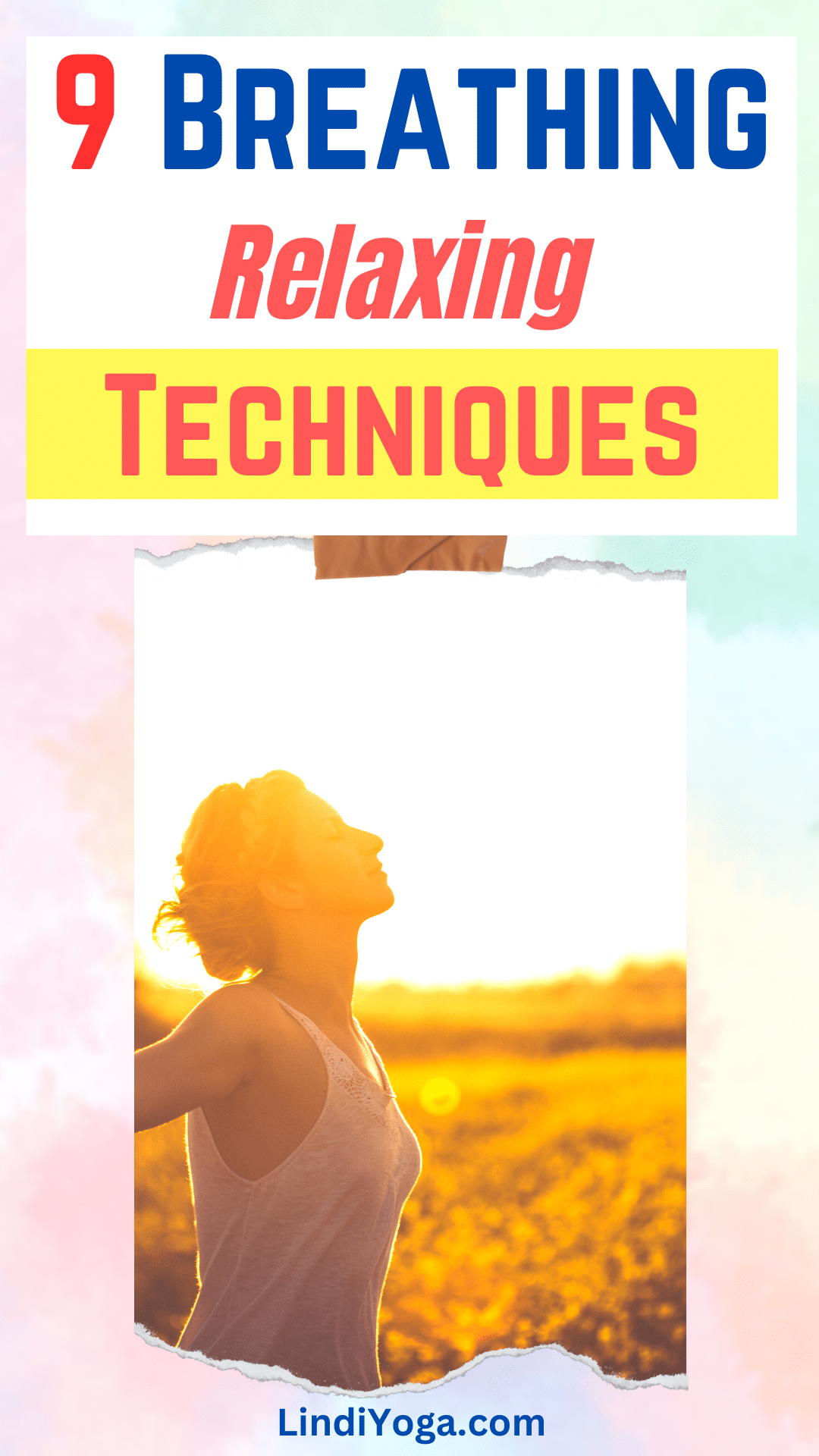
Resonant breathing
This section is about how to do resonance breathing.
How to do resonance breathing
- Below are three methods you can try to make your breath resonate. You do not need any equipment to do these breathing exercises.
- Breathe through the nose
- In this exercise, you breathe in through your nose and out through your mouth.
- After inhaling, close your mouth and keep it closed for a few seconds.
- Then breathe out slowly through the mouth. Repeat this process several times.
- Breathe through the mouth
In this technique, you breathe in through your mouth and out through your nose. The idea is the same as in the first method. But instead of closing your mouth, open it.
- Close your mouth again when you have finished breathing in and hold it open for a few seconds.
- Then breathe out slowly through your mouth.
- Breathe through both
- Finally, breathe in through the nose and out through the mouth.
- Open your mouth at the end of the inhalation and close it at the end of the exhalation. Then repeat the process.
- When you exhale, make sure the air leaves your lungs.
- Try to keep your mouth slightly open as you exhale.
Why resonant breathing is important
It helps you to control your emotions. Because when you breathe in, your body needs to fill up with oxygen. When you exhale, your body releases negative energy.
So when you practice resonance breathing, you can control your emotions and stay calm throughout the day.
Sitali breathing
Proper breathing is key in yoga. Sitali breathing can improve your health. This technique was created by Paramahansa Yogananda. It helps people worldwide feel calmer and more focused.
Sitali breathing helps you concentrate on one thing at a time. You focus your mind on a single object for at least 10 minutes. This reduces negative thoughts and worries.
With practice, you can focus without distraction during Sitali. It takes time but gets easier.
This breathing also improves sleep quality. It makes falling asleep easier. You wake up more refreshed.
Start by practicing Sitali for 3 minutes at a time. Do it in the morning and before bed.
Start slowly with just a few breaths. Once you master it, take more breaths.
It helps to practice with others. Get feedback on how you’re doing.
Work up to longer Sitali sessions. But begin small. This technique will relax your mind over time. Proper breathing brings many health benefits.
